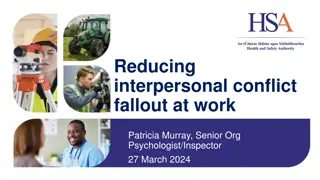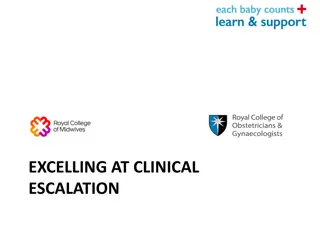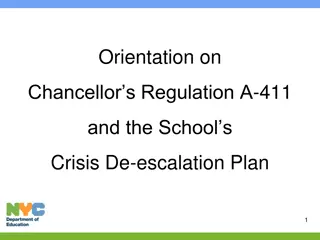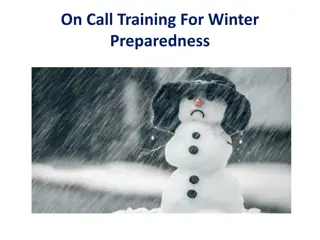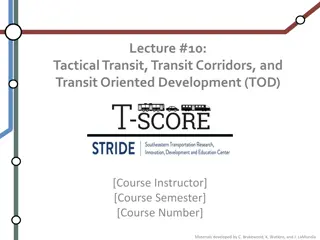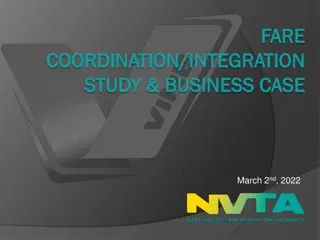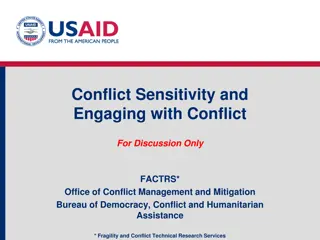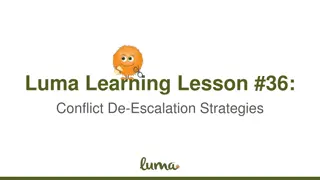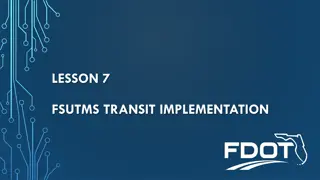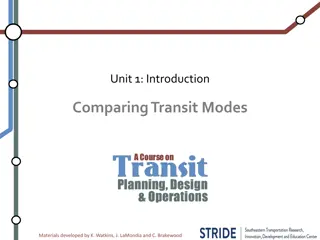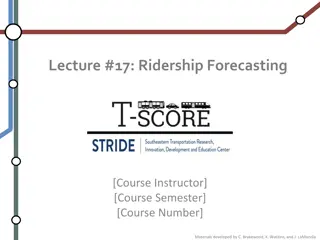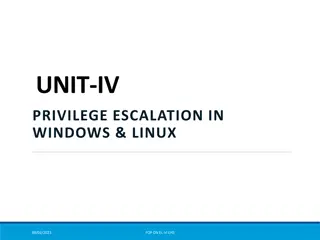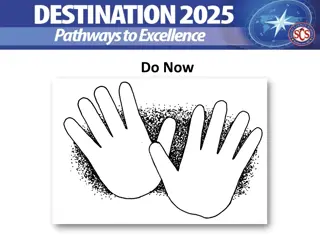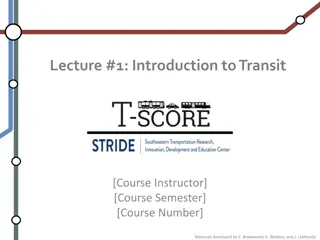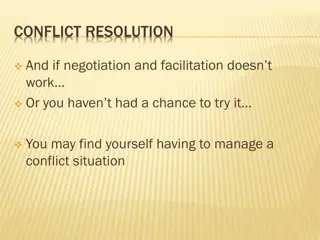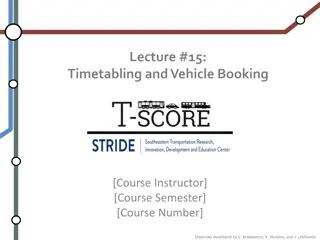Conflict Management and De-escalation Strategies for Transit Staff
This presentation by the Transit Association of Maryland (TAM) and Ream Lazaro Safety Consulting provides insights into the increasing assault injuries in transit since 2008, definitions of assault, assault types, contributing factors, basic needs of transit passengers, and passenger traits that may lead to conflicts. It emphasizes the importance of de-escalation skills and leadership strategies to ensure the safety and security of transit operators and customers.
Download Presentation

Please find below an Image/Link to download the presentation.
The content on the website is provided AS IS for your information and personal use only. It may not be sold, licensed, or shared on other websites without obtaining consent from the author. Download presentation by click this link. If you encounter any issues during the download, it is possible that the publisher has removed the file from their server.
E N D
Presentation Transcript
CONFLICT MANAGEMENT AND DE-ESCALATION STRATEGIES FOR TRANSIT STAFF Transit Association of Maryland (TAM) Ream Lazaro Safety Consulting, LLC 1
OVERVIEW 2
Agenda Defining the Risk De-escalation Skills Leadership Strategies 3
Since 2008, number of assault injuries in transit more than tripled. Includes: operator injuries vehicle rider injuries, and injuries to people waiting for or leaving the bus 6
Definition of Assault Overt physical and verbal acts of aggression by passenger Interferes with mission of transit operator Adversely affects safety of operator and customers 7
Assault Type Verbal threats / intimidation / harassment Spitting Projectiles thrown at bus Projectiles thrown inside bus (including liquids) While vehicle is in motion Due to operator race / gender /size Simple assault Involves weapons 81% 60% 38% 26% 9% 5% 3% 2% 8
Contributing Factors Fare enforcement Intoxicated passengers or drug users Other rule enforcement School / youth-related violence Individuals with mental illness Routes operating in high-crime areas Service problems (delays, service reductions, etc.) Gang-related violence Cash Transactions 67% 66% 53% 48% 40% 26% 24% 12% 3% 9
Basic Needs of Transit Passenger Reliability Safety and security Convenience and accessibility Cleanliness and comfort Simplicity Affordable Friendliness and empathy 10
Passenger Traits That May Lead to Conflict Under the influence of alcohol or drugs Mental health issues Under high personal stress People who are transient or homeless Resent authority and regulations Teenagers acting out Angry about transit service 11
Examples of Conflict Sources Unwanted advances or harassment Shouting or loud music Bullying Language or cultural differences Other inappropriate behavior Pandemic requirements Fare disputes Use of profanity Bringing food or drink onboard Delays in service Vandalism of vehicle Objects being thrown 12
Time Periods of Assaults Evening / late night / early morning PM peak period School dismissal times During school runs AM peak period Midday No discernible pattern 48% 38% 28% 12% 8% 7% 33% 13
Review Assaults can include both verbal and physical threats and attacks Fare disputes, rule enforcement, and service problems often trigger assaults Time of day and location can raise the risk of assaults Operators still have to drive the bus 14
REALITY CHECK The Risk 15
What is Conflict? Conflict is a disagreement in which the people involved see a threat to their needs, interests, or concerns. Conflict key element the idea that each person may have a different perception of any given situation 17
What is de-escalation? De-escalation - when we use communication skills to calm a person who is angry, out of control, or disturbed. Escalation phase when interaction turns into conflict Critical to deploy de-escalation techniques during this phase 18
Types of Conflict Passenger against driver Passenger against supervisor Passenger against passenger 19
Three Aspects of Communication Words (what we actually say) Tone (how we say the words) Body language Combine to express an overall message A powerful form of communication 20
Making a Good First Impression First impressions form within the first second of interaction First impression is an evaluation based on your appearance body language demeanor and mannerisms Greet passengers with warm, confident smile to put at ease Make eye contact to create connection May identify passengers who might be inclined to be disruptive Way of letting passengers know you are watching what is going on 21
Triggering Events Triggering event an incident perceived as a threat by an individual Two types of triggering events: Fear inducing person feels threatened or believes is about to lose something of value Frustrating person feels their needs are not being met 22
Situational Awareness Situational awareness helps you recognize and read the indicators of difficult passengers Assess situation in a non-emotional way Be mindful of your own stress responses Don t allow yourself to be provoked Maintain your self-control and composure 23
CAIRO Method of Conflict Management C Calm A Assertive I Informing behavior Use we statements rather than you R Reflect / Redirect Don t Don t raise your voice use neutral, consistent tone Don t Don t come across as controlling, parental, insecure, or aggressive Listening and showing person you heard them O Opening behavior Ask questions that enable person to open up and express themselves 24
Some Signs of Conflict Escalation Sudden change in tone of voice or volume Clenching fists or tightening and untightening jaw Begins fidgeting or pacing Crossed arms Change in type of eye contact or evasive eye contact Rooster stance Chest protruding and arms held away from body 25
More Signs of Conflict Escalation Lowering of the body Not standing up straight or hunched over Heavy breathing Raised / hidden hands Holding hands in air out of frustration Hiding hands behind back or in pockets Disruptive behaviors Yelling, bullying, actively defying or refusing to comply with rules 26
Reducing Escalation - Aggression Aggression breeds aggression, escalating a bad situation into an emergency. Handle the situation from the driver s seat when possible Respect the offender s personal space Maintain a calm demeanor Project a sense of control without being aggressive 27
Reducing Escalation - Tactics First, calm yourself before interacting with person Take a deep breath Don't get defensive even if insults are directed at you Try to look as non-threatening as possible Listen to persons concerns without passing judgment Use a low, dull tone of voice Make personal connection For example, What s your name? Get them to say yes Shift conversation to future Creates hope; makes you less threatening 28
Reducing Escalation More Tactics Treat every passenger with respect Don t embarrass or humiliate person Don t intimidate person Speak clearly and calmly Use repetition Cameras on vehicles Don t be surprised if they overreact Don t touch sleeping passengers May be under the influence, confused, violent, armed 29
Reducing Escalation Do NOT say this Calm down May be perceived as an order I understand Understanding must be demonstrated Why Feels accusatory, creates defensiveness You should and You shouldn t Judgmental statements that may cause feelings of inadequacy, shame, or anger 30
Reducing Escalation Do NOT do this Make light of person s experiences Trivialize person s problems Dismiss person s feelings Blame person Be sarcastic Treat person as unintelligent Argue moral issues Expect agreement to develop quickly 31
Respond versus React Responding conscious action Reacting unconscious action Responding based on thought out strategy Reacting generally random Responding requires preparation Reacting shows lack of preparedness Responding requires emotions be under control Reacting shows lack of control 32
Identify Your Hot Buttons Know your hot buttons Develop strategies to overcome reactions to your hot button being pushed Practice positive self-talk to calm yourself down and maintain self-control Don t take the bait 33
Consider Avoidance Consider conflict avoidance If issue is minor Further confrontation would result in escalation Do not use avoidance if issue needs to be addressed Do not compromise safety rules 34
Take a Time Out Give yourself time to calm down Think through how to handle the situation 35
Listen and Repeat Key Points Listening most critical element of communication Listen to: Identify the problem Filter out unnecessary information Put into words what you think problem is Repeat back the key points for clarification 36
Ask Open-ended Questions Ask questions to make passenger think rather than react Use who, what, where, when, and how questions To clarify the situation Get passenger to respond rationally 37
Offer Help or Options Offer help or options To emphasize your concern and empathy Keep messages short and clear 38
Give Choices and Consequences Set limits To make clear there are expectations for acceptable behavior When passenger s behavior indicates further conversation will not help State expectation Give negative choice and consequence first Give positive choice and consequence last 39
Take Action Ask Explain Present options Confirm Act 40
Responding to Danger Requesting response Panic button or silent alarm Verbal emergency code Vehicle positioning and doors Choose escape route Rural and remote locations Follow agency specific procedures for handling conflict and responding to danger. 41
Review CAIRO Method Words, tone of voice, body language Respond versus react Identify hot buttons Show empathy and listen Get passenger to respond rationally Give choices and consequences Act 42
REALITY CHECK De-escalation 43
Role of Dispatcher Try to guide operator reactions to conflict event Facilitate supervisor and/or operator response to vehicle Maintain radio contact Record information on event Immediately report to upper management 45
Role of Supervisor Coach operator s on conflict management and de- escalation skills When opportunity arises and no passengers are around Respond to vehicle when requested Use de-escalation skills Request law enforcement response, if necessary Complete follow-up report 46
Role of Trainer Provide operators new-hire and refresher training and re-training on conflict management and de-escalation skills During training, rely heavily on role play and case studies 47
Relationship with Law Enforcement Work to build on-going relationships Increase law enforcement visibility at hot spots Provide copies of transit policies, rules, and regulations that could be catalyst for passenger conflict Conduct hot wash create After-Action Report Share with law enforcement 48
Policies and Procedures Orient operators, supervisors, dispatchers on policies / procedures that could generate passenger conflict Periodically review those policies /procedures Revise as necessary Update operators, supervisors, dispatchers on revised policies /procedures 49
Routes and Schedules When addressing service design challenges Consider information on: high risk crime areas gang activity areas high risk times of day day of week time of year Attempt to address assault risk through service design Periodically conduct live evaluations of all routes at all times and days of week 50

 undefined
undefined
 undefined
undefined


